|
|
 |
|
Calanoida ( Order ) |
|
|
|
Ryocalanoidea ( Superfamily ) |
|
|
|
Ryocalanidae ( Family ) |
|
|
|
Ryocalanus ( Genus ) |
|
|
| |
Ryocalanus brasilianus Renz, Markhaseva & Schulz, 2013 (F,M) | |
| | | | | | | Ref.: | | | Renz & al., 2013 (p.247, Descr.F,M, figs.F,M, Rem.) | 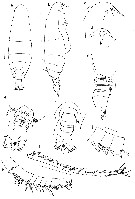 Issued from : J. Renz, E.L. markhaseva & K. Schulz in Zoosyst. Evol., 2013, 89 (2). [p.249, Fig.2]. Female (35°13.90'S, 26°34.78'W): a-b, habitus (dorsal and lateral, respectively); c-d, rostrum (lateral and ventral, respectively); e, pediger 4-5 and urosome (ventral; dotted setae additions after paratype, broken in holotype); f, pediger 5 and urosome; g, pediger 5 and urosome (lateral); h, A1 (segments I-XIII); i, A1 (segments XIV-XXVIII); j, A1 (segmentsV-VII as in paratype). Scale bars: 0.5 mm (a-b, h-i); 0.1 mm (c-j).
|
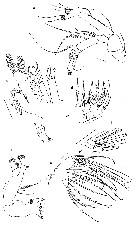 Issued from : J. Renz, E.L. markhaseva & K. Schulz in Zoosyst. Evol., 2013, 89 (2). [p.250, Fig.3]. Female: a, A2; b, Md; c, Mx1 (praecoxal arthrite not figured); d, praecoxal arthrite of Mx1; e, Mx2 (dotted setae additions after paratype, broken in holotype); f, endopod of Mx2. Scale bars: 0.1 mm. Nota: Md: Gnathobase cutting edge with 8 unequal teeth plus ventral seta; exopodal segments incompletely fused, with 6 setae; endopod 2-segmented. Mx1: Praecoxal arthrite with 9 terminal spines, 3 posterior and 2 anterior setae; posterior surface with small spinules. Coxal endite with 6 setae, coxal epipodite setae broken in holotype, with 9 setae in paratype. proximal basal endite with 4 setae, distal basal endite with 5 setae and small surface spinules. Endopod with 13 setae and patch of small surface spinules. Exopod with 11 setae. Mx2: basis (formerly considered coxa) with 1 outer seta; praecoxal endite bearing 4 setae, coxal endite (formerly considered distal praecoxal endite) with 3 setae each; lobe of proximal endopodal segment (formerly considered proximal basal endite) with 4 setae; all endites with surface spinules. Endopod with 7 / 2 setae.
|
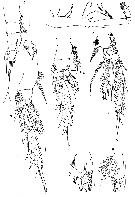 Issued from : J. Renz, E.L. markhaseva & K. Schulz in Zoosyst. Evol., 2013, 89 (2). [p.252, Fig.4]. Female: a, Mxp; b, P1 with endopodite figured separately; c, P2; d, P3; e, P4 (left leg); f-g, coxa of right P4 (different views). Scale bars: 0.1 mm. Nota: Mxp, syncoxa with 1 seta proximal praecoxal endite, 2 setae on middle endite, and 3 setae on distal praecoxal endite; coxal endite with 3 setae. Basis with 3 medial setae plus 2 setae distally on partly incorporated endopod segment 1; endopod of 5 free segments with 4, 4, 3, 3 + 1, and 4 setae.
|
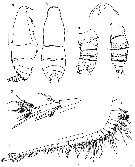 Issued from : J. Renz, E.L. markhaseva & K. Schulz in Zoosyst. Evol., 2013, 89 (2). [p.253, Fig.5]. Male: a, habitus (lateral); b, same (urosome not figured); c, rostrum (ventral); d-e, urosome (dorsal and lateral, respectively); f, left A1; g, left A1 (segments XXV-XXVIII). Scale bars: 0.5 mm (a-b, f); 0.1 mm (c-d, g). Nota: Cephalosome and pediger 1 separate, pedigers 4 and 5 separate In lateral view, posterolateral corners of prosome extended posteriorly into points slightly extending urosomite 1. Caudal rami almost symmetrical, with 4 terminal plus 1 small dorsal and 1 ventral setae each. Left A1 unmodified, 24 free segments, extending to urosome.
|
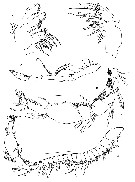 Issued from : J. Renz, E.L. markhaseva & K. Schulz in Zoosyst. Evol., 2013, 89 (2). [p.254, Fig.6]. Male: a, right A1; b, right A1 (segments XIX-XXVIII); c, Mx1; d, Mx2; e, Mxp with endopod separate. Scale bars: 0.1 mm (a-c, e); 0.5 mm (d). Nota: Right A1 geniculated and strongly modified, 23 free segments. A2 and Md similar to those of female. Mx1: praecoxal arthrite with 9 terminal spines and 4 posterior setae; posterior surface of praecoxal arthrite with small spinules; coxal endite with 6 setae, coxal epipodite with 5 setae (partly broken); proximal basal endite with 4 setae, distal basal endite with 5 setae; endopod with 9 setae; exopod with 11 setae. Mx2: basis with 1 outer seta: praecoxal endite bearing 4 setae; coxal endite with 3 setae; basal endites with 3 setae each; lobe of proximal endopodal segment with 4 setae; all endites with surface spinules. Endopod with 7 + 2 setae. Mxp: syncoxa with 1 seta on proximal praecoxal endite, 2 setae on middle endite, and 3 setae on distal praecoxal endite; coxal endite with 3 setae. Basis with 3 medial setae plus 2 setae distally of partly incorporated endopod segment 1; endopod of 5 free segments with 4, 4, 3, 2, and 3 setae. Renz & al. (2013, p.255) underline that the present interpretation of the segmentation of the male geniculated antennula is based on the interpretation proposed by Tanaka (1956) and Ohtsuka & Huys (2001); however, the present pattern of segmentation described herein does not completely fit in either of their descriptions, since a fusion of 2 ancestral segments proximal to the fused ancestral segments XXVII and XXVIII, in R. infelix indicated by a small terminal seta on segment XXV (Tanaka, 1956), is not observed in R. brasilianus. The interpretation of its segmentation therefore remains tentative and has to await new morphological data on more species of this genus.
|
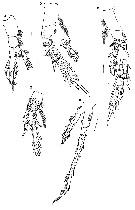 Issued from : J. Renz, E.L. markhaseva & K. Schulz in Zoosyst. Evol., 2013, 89 (2). [p.256, Fig.7]. Male: a, P1 with endopodite separate; b, P2 with endopodite separate; c, P3 with exopodal segments 2 and 3 separate; d, P4 exopodal segments 2-3 missing; e, P5. Scale bars: 0.1 mm. Nota: Segmentation of swimming legs P1 to P4 as in female.
P5 uniramous on both sides, covered with rows of spinules on posterior surface. Right leg with 2-segmented exopod, shorter than left leg. Right leg basis with medial spine, exopod segment 1 with distolateral spine, segment 2 with 2 terminal spines. Left leg with 3-segmented exopod; left exopod basis with medial spine, exopod segment 1 with disto-lateral spine, terminal segment with 2 spines.
| | | | | NZ: | 1 | | |
|
Distribution map of Ryocalanus brasilianus by geographical zones
|
| | | | Loc: | | | S Atlantic (Brazilian Basin)
Locality type: 35°13.90'S, 26°34.78'W & 29°57.37'S, 14°58.41'W. | | | | N: | 1 | | | | Lg.: | | | (1143) F: 2,88-3,04; M: 2,76; {F: 2,88-3,04; M: 2,76} | | | | Rem.: | Above the sea bed (4484 m) | | | Last update : 05/02/2015 | |
|
|
 Any use of this site for a publication will be mentioned with the following reference : Any use of this site for a publication will be mentioned with the following reference :
Razouls C., Desreumaux N., Kouwenberg J. and de Bovée F., 2005-2024. - Biodiversity of Marine Planktonic Copepods (morphology, geographical distribution and biological data). Sorbonne University, CNRS. Available at http://copepodes.obs-banyuls.fr/en [Accessed April 18, 2024] © copyright 2005-2024 Sorbonne University, CNRS
|
|
 |
 |









